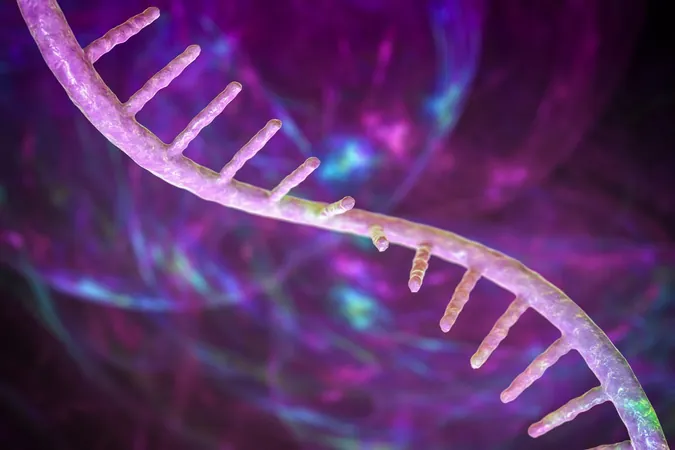
Groundbreaking Blueprint of the Human Spliceosome Opens New Doors for Cancer Treatments
2024-10-31
Author: Wei Ling
Groundbreaking Blueprint of the Human Spliceosome Opens New Doors for Cancer Treatments
Researchers at the Centre for Genomic Regulation (CRG) have unveiled the first comprehensive blueprint of the human spliceosome—an intricate molecular machine essential for editing genetic messages sourced from DNA. This groundbreaking discovery allows our cells to craft various protein versions from a single gene, shedding light on the complex processes underpinning gene expression.
The implications of this research are profound: the detailed map of the spliceosome is expected to revolutionize therapeutic strategies targeting RNA processing in diseases tied to erroneous RNA molecules resulting from splicing mistakes, such as various cancers. By making this resource publicly available, researchers now have the tools to identify specific splicing errors within a patient's cells, potentially leading to tailored treatments.
The endeavor to construct this significant resource took over a decade. Dr. Juan Valcárcel, an ICREA research professor at CRG and senior author of the study published in the journal Science, remarked, “This blueprint can extend the success seen in treating rare conditions like spinal muscular atrophy to more widespread diseases, bringing therapeutic innovations into mainstream medicine.”
Malgorzata Rogalska, co-corresponding author of the paper, emphasized that while current treatments primarily focus on rare diseases, we are on the brink of a new era. “We are moving towards therapies that operate at the transcriptional level—offering disease-modifying options rather than merely addressing symptoms. The blueprint we have created paves the way for entirely new therapeutic strategies.”
The spliceosome consists of about 150 distinct proteins and five small RNA molecules that collaboratively execute the RNA editing process. Until this study, the specific roles of these components had remained somewhat mysterious. Splicing errors are linked to an extensive range of diseases—including neurodegenerative disorders and various cancers—highlighting the importance of understanding how splicing operates at a molecular level.
The research team systematically knocked down the expression of hundreds of splicing-related protein-coding genes in human cancer cells. Their findings revealed that individual spliceosome components play highly specialized roles, which has significant ramifications for drug development. Valcárcel's metaphor of the spliceosome as a "collection of flexible chisels" highlights the precision with which cells sculpt genetic messages, akin to fine art.
Importantly, the research identified that disruption of one spliceosome component can have cascading consequences throughout the entire splicing network. This interconnectedness may expose vulnerabilities in cancer cells, which often undergo rewiring of their splicing machinery to evade traditional therapies targeting DNA mutations.
For instance, the research focused on the spliceosome component SF3B1, frequently mutated in cancers like melanoma and breast cancer. The study revealed that manipulating SF3B1’s expression can trigger a chain reaction affecting a significant portion of the splicing network, overwhelming the cancer cells' capacity to grow and survive.
"Understanding these interconnections could lead to the development of novel drugs that target these splicing vulnerabilities," asserted Valcárcel. The potential here is substantial: while many current cancer treatments struggle with resistance issues, targeting the spliceosome could exploit cancer cells' dependence on a complex splicing network.
The importance of this research extends beyond cancer, as splicing issues are also implicated in various genetic disorders and neurodegenerative diseases. With the detailed map of the spliceosome at their disposal, researchers can now more accurately diagnose and develop interventions for diseases caused by splicing dysfunctions.
Dom Reynolds, Chief Scientific Officer at Remix Therapeutics, a biotechnology company collaborating on the study, commented on the research's relevance: “This pioneering work not only enhances our understanding of the spliceosome's intricate functions but also opens avenues to target RNA processing for better therapeutic outcomes in various diseases associated with splicing dysregulation.”
The significance of this first spliceosome blueprint cannot be overstated. As researchers align their sights on translating these findings into effective treatments, the future of medicine may very well hinge on unraveling the complexities of RNA editing and splicing. Innovations birthed from this work could one day change the landscape of how we combat cancer and other diseases linked to splicing errors, heralding a new era of targeted therapies.
Stay tuned as this research progresses, and watch for exciting updates on potential new treatments that could redefine our approach to genetic-related ailments!


 Brasil (PT)
Brasil (PT)
 Canada (EN)
Canada (EN)
 Chile (ES)
Chile (ES)
 España (ES)
España (ES)
 France (FR)
France (FR)
 Hong Kong (EN)
Hong Kong (EN)
 Italia (IT)
Italia (IT)
 日本 (JA)
日本 (JA)
 Magyarország (HU)
Magyarország (HU)
 Norge (NO)
Norge (NO)
 Polska (PL)
Polska (PL)
 Schweiz (DE)
Schweiz (DE)
 Singapore (EN)
Singapore (EN)
 Sverige (SV)
Sverige (SV)
 Suomi (FI)
Suomi (FI)
 Türkiye (TR)
Türkiye (TR)